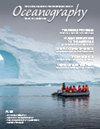Application of Remote Sensing and GIS to Identifying Marine Fisheries off the Coasts of Kenya and Tanzania
IF 2.8
4区 地球科学
Q1 OCEANOGRAPHY
引用次数: 0
Abstract
10°S 38°E 38°E 38°E 42°E 42°E 42°E 40°E 40°E 40°E 44°E 44°E 44°E 0 100 200 300 Kilometers Two case studies demonstrate that the application of satellite remote sensing and GIS techniques can inform the development and improvement of fishing policies and fishery management in Kenya and Tanzania. Artisanal coastal fishing communities in both countries still rely on traditional methods to identify fishing grounds. The rudimentary techniques they use are based on conservative hunting methods that rely on recurrent experiences and evidence gathering among fisherfolk. However, multiple environmental factors determine the spatial structure and distribution of pelagic fisheries (Planque et al., 2011), and marine organisms are highly vulnerable to the rapid variations in oceanographic conditions that are being accelerated by global changes. These changes contribute to the broad diversity in species distribution and assemblages in space and time, further complicating fishers’ quests for productive grounds. Biophysical indicators of the sea surface environment such as temperature and chlorophyll concentration may serve as important determinants of the presence of marine life. Physical processes in the upper ocean such as currents, waves, and tides stimulate biological processes that ultimately determine the distribution of pelagic fish (Solanki et al., 2005). A thorough understanding of key environmental parameters and their influence on pelagic fish distribution can inform exploration for prospective fishing zones. Chlorophyll-a (Chl-a) concentration is a measure of the algae present in seawater and can be used as an indicator of fish production. The microscopic algae form the top of the marine food web and are consumed by zooplankton and small fish, which are then consumed by larger fish. Similarly, sea surface temperature (SST) is a significant physical factor that strongly influences the physiology and growth of ocean life, including phytoplankton and all other organisms at higher trophic levels (Tang et al., 2003), and can be used to help identify fishing grounds. Collecting measurements of oceanographic parameters from boats over large areas is time consuming and expensive and can be impractical for identifying commercially viable fishing areas due to the dynamic nature of the ocean. Consequently, there is a need for more effective methods that can capture changes instantaneously over broad regions. Satellite sensors can be used to gather information on global ocean SST and Chl-a concentration at relatively high resolutions over broad regions and long time periods. Geographic Information System (GIS) techniques can then be used to integrate satellite images with spatial databases (e.g., Microsoft SQL Server, Oracle, PostgreSQL) and statistical techniques to inform fisheries management. A pilot case study in Kenya involved the discovery of potential yellowfin tuna fishing grounds using satellite data on oceanographic parameters selected based on their relevance as descriptors of tuna habitat. SST, sea surface Chl-a, and mean sea level anomalies obtained from Application of Remote Sensing and GIS to Identifying Marine Fisheries off the Coasts of Kenya and Tanzania遥感和地理信息系统在肯尼亚和坦桑尼亚沿海海洋渔业识别中的应用
10°S 38°E 38°E 42°E 42度E 42度E 40°E 40°E 44°E 44度E 0 100 200 300公里两个案例研究表明,卫星遥感和地理信息系统技术的应用可以为肯尼亚和坦桑尼亚制定和改进渔业政策和渔业管理提供信息。这两个国家的个体沿海捕鱼社区仍然依靠传统方法来识别渔场。他们使用的基本技术是基于保守的狩猎方法,这些方法依赖于渔民的反复经验和证据收集。然而,多种环境因素决定了中上层渔业的空间结构和分布(Planque et al.,2011),海洋生物极易受到全球变化加速的海洋条件快速变化的影响。这些变化导致了物种分布和组合在空间和时间上的广泛多样性,使渔民对生产场地的追求更加复杂。海面环境的生物物理指标,如温度和叶绿素浓度,可能是海洋生物存在的重要决定因素。上层海洋的物理过程,如洋流、波浪和潮汐,刺激了最终决定中上层鱼类分布的生物过程(Solaki等人,2005年)。深入了解关键环境参数及其对中上层鱼类分布的影响,可以为勘探潜在捕鱼区提供信息。叶绿素a(Chl-a)浓度是衡量海水中藻类含量的指标,可作为鱼类产量的指标。微小的藻类形成了海洋食物网的顶部,被浮游动物和小型鱼类吃掉,然后被大型鱼类吃掉。同样,海面温度(SST)是一个重要的物理因素,它强烈影响海洋生物的生理和生长,包括浮游植物和所有其他营养级较高的生物(Tang et al.,2003),并可用于帮助识别渔场。从大面积的船只上收集海洋学参数的测量值既耗时又昂贵,而且由于海洋的动态性质,对于确定商业上可行的捕鱼区来说可能不切实际。因此,需要更有效的方法,能够在大范围内即时捕捉变化。卫星传感器可用于在宽区域和长时间内以相对高的分辨率收集全球海洋SST和Chl-a浓度的信息。地理信息系统(GIS)技术可用于将卫星图像与空间数据库(例如,Microsoft SQL Server、Oracle、PostgreSQL)和统计技术集成,为渔业管理提供信息。肯尼亚的一项试点案例研究涉及利用卫星数据发现潜在的黄鳍金枪鱼渔场,这些数据是根据其相关性选择的海洋学参数,作为金枪鱼栖息地的描述符。应用遥感和GIS识别肯尼亚和坦桑尼亚沿海海洋渔业的SST、海面Chl-a和平均海平面异常
本文章由计算机程序翻译,如有差异,请以英文原文为准。
求助全文
约1分钟内获得全文
求助全文
来源期刊

Oceanography
地学-海洋学
CiteScore
6.10
自引率
3.60%
发文量
39
审稿时长
6-12 weeks
期刊介绍:
First published in July 1988, Oceanography is the official magazine of The Oceanography Society. It contains peer-reviewed articles that chronicle all aspects of ocean science and its applications. In addition, Oceanography solicits and publishes news and information, meeting reports, hands-on laboratory exercises, career profiles, book reviews, and shorter, editor-reviewed articles that address public policy and education and how they are affected by science and technology. We encourage submission of short papers to the Breaking Waves section that describe novel approaches to multidisciplinary problems in ocean science.
 求助内容:
求助内容: 应助结果提醒方式:
应助结果提醒方式:


